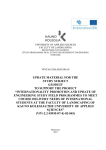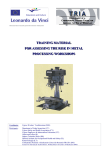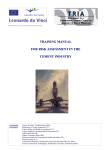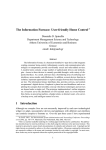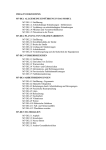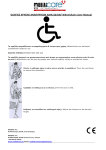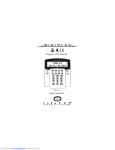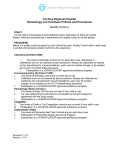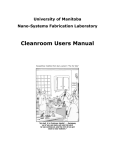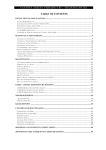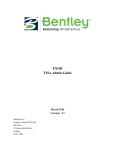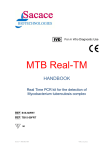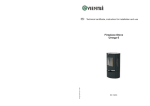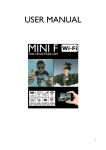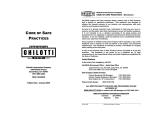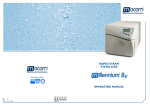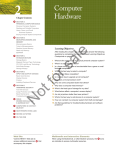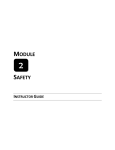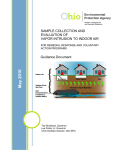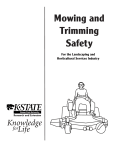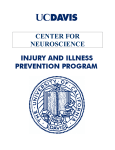Download training material for assessing the risk in road side services
Transcript
This document does not necessarily represent the Commission’s official position T TR RA AIIN NIIN NG GM MA AT TE ER RIIA AL L FFO ER RIISSK K IIN N OR RA ASSSSE ESSSSIIN NG GT TH HE R RO OA AD D SSIID DE E SSE ER RV VIIC CE ESS Coordinator: Cyprus Workers’ Confederation (SEK) Participants: Department of Labor Inspection (CY) Cyprus Safety and Health Association (CY) Cyprus Employers & Industrialists Federation (CY) Arbeit und Leben (D) Odense Techniske Skole (DK) Hellenic Institute for Occupational Health and Safety (EL) Kauno Kolegija (LT) Confederatia National A Sindicatelor Libere din Romania-FRATIA (RO) Center for Advanced Technologies, Politechnic University of Bucharest (RO) TABLE OF CONTENTS M7-EN.1 GENERAL INTRODUCTION TO THE MODULE M7-EN.1.1 Introduction M7-EN.1.2 Occupational injuries M7-EN.1.3 Prevention of occupational injuries M7-EN.1.4 Duties and responsibility M7-EN.1.5 Prevention in practice M7-EN.2 PROJECTING OF ROAD WORKS M7-EN.2.1 Introduction M7-EN.2.2 Height of road M7-EN.2.3 Width of road M7-EN.2.4 The scope of the marking M7-EN.2.5 Works Area M7-EN.2.6 Traffic regulation and Flaggers’ safety M7-EN.3 SIGNS M7-EN.3.1 Introduction M7-EN.3.2 Setting out signs M7-EN.3.3 Warning signs M7-EN.3.4 Prohibition and mandatory signs M7-EN.3.5 Information and direction signs M7-EN.3.6Marginal strip lining M7-EN.3.7 Marking on the roadway M7-EN.4 WORKING CONDITIONS M7-EN.4.1 Introduction - ergonomics M7-EN.4.2 Manual handling M7-EN.4.3 Strain of working positions and movements M7-EN.4.4 Mental stress M7-EN.4.5 Noise M7-EN.4.6 Lighting M7-EN.4.7 Night work M7-EN.4.8 Vibration M7-EN.4.8.1 Hand and Arm Vibration M7-EN.4.8.2 Whole Body Vibration M7-EN.4.9 Weather Conditions M7-EN.4.9.1 Cold M7-EN.4.9.2 Heat M7-EN.4.10 Electrical Hazards M7-EN.4.10.1 Overhead power lines M7-EN.4.10.2 Underground power lines M7-EN.4.10.3 Accidents with electricity M7-EN.4.11 Falls M7-EN.4.11.1 Trenching M7-EN.4.11.2 Cave-ins M7-EN.4.12 Runovers and backovers M7-EN.5 MATTER AND MATERIAL M7-EN.5.1 Asphalt M7-EN.5.2 Silica M7-EN.5.3 Wet concrete M7-EN.5.4 Lead M7-EN.5.5 Other health hazards M7-EN.6 MACHINES M7-EN.6.1 Introduction – operator’s safety M7-EN.6.2 Transport machines M7-EN.6.3 Construction machines M7-EN.6.4 Excavation work M7-EN.6.5 Cranes M7-EN.7 MOBILE ROAD WORKS M7-EN.7.1 Introduction M7-EN.7.2 Continuous mobile road works M7-EN.7.3 Short-term road works M7-EN.7.4 Road striping and other mobile road works M7-EN.8 RESCUE WORK M7-EN.8.1 Introduction M7-EN.8.2 Work at scene of accident and traffic regulation M7-EN.9 REFERENCES M7-EN.10 RISK ASSESSMENT M7-EN.11 EVALUATION TEST M7-EN.1 GENERAL INTRODUCTION TO THE MODULE M7-EN.1.1 Introduction M7-EN.1.2 Occupational injuries M7-EN.1.3 Prevention of occupational injuries M7-EN.1.4 Duties and responsibility M7-EN.1.5 Prevention in practice M7-EN.1.1 Introduction In this chapter, some concepts and methods in the prevention of occupational injuries are introduced. The aim of the chapter is to provide a general understanding of the concepts of occupational injuries and work-related diseases as well as occupational accidents and injuries due to long-term impact. In the chapter, the responsibility of employers and employees is also stated related to the safety and health of the workplace. It is also the aim of this chapter to introduce the methods provided for workplace assessment and accident analysis with a view to preventing occupational injuries and work-related diseases. This chapter provides an overview, whereas the following chapters, chapters 2-5, give detailed descriptions of the risks in road works and rescue work. These chapters examine more closely what safety measures can be taken to prevent accidents and injuries. Serious accidents that involve the vehicles that are in the road are of main concern for the road workers. (M7-EN1-1.jpg) Building projects in connection with road works also imply a number of other hazards such as injuries from lifting, poisoning by inhalation of hazardous substances, cauterization/corrosion, burns and being worn-out after long-term impact. These hazards have not been included in this module. Instead, we refer to the modules directly relating to this type of work such as Module 7 on construction work. The provisions for traffic regulation and marking of road works are to be found in the Road Traffic Act as well as consolidation acts and circulars pertaining to it. M7-EN.1.2 Occupational injuries – definitions Occupational injuries, is a generic term referred to the injuries incurred during work, as well as diseases directly related to the work environment An occupational accident means a sudden, unexpected accident causing injury. The accident must take place during work and cause bodily injury, e.g. a fall from a roof. It is of no importance what type of work it is and how the injury has happened. An occupational disease means an illness, which has arisen after long-term impact of the specific job or the conditions of the job, e.g. cancer resulting from working with asbestos. In certain cases, it is difficult to draw a sharp line between what is an accident and what is an occupational disease. Examples − Road accidents where the injured person is at work is an occupational accident − A hearing impairment caused by an explosion is an occupational accident whereas a hearing impairment resulting from long-term work in an environment of loud noise is an occupational disease − A back injury resulting from a fall is an accident whereas a back injury caused by long-term work in the wrong working position is an occupational disease M7-EN.1.3 Prevention of occupational injuries Generally, both accidents and occupational diseases can be prevented by encouraging good attitudes to the work environment. If an accident or an occupational disease has occurred, it is important that you learn from it so that in future similar injuries can be avoided. This can happen if the company systematically investigates and analyses the accidents and occupational diseases, which occur. When an accident occurs, the injured person often blames himself. Even more often, others blame him for the accident. People then are content with these conclusions and do not take any further action. However, if you want to assist in safety, you have to adopt a different attitude. You have to look for the causes of the accident and find the conditions that need to be changed. You have to look at the conditions that affect people’s behaviour and the way in which their work is organised, including technical arrangements, work procedures, etc. Please note that the purpose of analysing the causes for injuries arising is not to find the guilty or responsible parties, but to find and change the conditions causing the accidents or occupational diseases! The following three-point model is suitable for the prevention of occupational accidents. Mapping the facts − Gather information about factual incidents in connection with the accident − If possible, take photos or draw sketches − Do it as fast as possible after the accident Clear up the accident − Carry out a step-by-step analysis of the events leading to the accident − Base the analysis solely on the facts collected during the mapping Find safe solutions that are preventive − Go through each step of the analysis for possible preventive measures − Estimate the sequence of preventive measures and decide what should be carried out immediately and what should be carried out later − Agree on deadlines and determine who is responsible that the measures are implemented M7-EN.1.4 Duties and responsibilities in the work environment As a principal rule, the employer is responsible for workplace safety and for compliance with the legislation. Thus, it is also the employer’s duty to take on an active role in safety and health on the job. The employer does not however bear full responsibility. Also managers and supervisors at various levels, the employees and suppliers of machines, equipments and aids bear their share of responsibility. The employer’s responsibility − The work – including work with machines, technical aids, chemicals, other substances and equipments – must be planned and executed in complete accordance with safety and health regulations − The workplace must be arranged securely in relation to ventilation, cold and draught, dangers of crash or collapse, etc. − The employees should have the necessary training in a safe manner of working − There should be supervision that the work is carried out according to given instructions Managers and supervisors act as the employer’s representatives and have – each one at his/her own level – the same responsibility as the employer. The employees’ responsibility − Assist in working conditions being in complete accordance with safety and health regulations − Use the personal appliances for protection distributed to them − Report flaws and defects to the supervisor if they cannot repair them immediately Suppliers − Machines must be supplied with the necessary protective equipment and simple instructions − Scaffolds must be suited for the work they have been ordered for, and they should be set up in a safe manner according to regulations Furthermore, the builder and the constructors are also responsible that the work is carried out in the most appropriate way regarding health and safety during work. M7-EN.1.5 Prevention in practice Workplace assessment is one of the best tools for systematising the work on the occupational environment and the prevention of injuries. Workplace assessment must cover the entire work environment of the company or the building site. I.e., the estimate should comprise as a minimum: − Physical impacts (e.g. light, noise, cold and draught) − Chemical impacts − Biological impacts (e.g. risks of infection) − Ergonomic impacts (e.g. work positions and heavy lifting) − Mental impacts (job satisfaction) − Risks of accidents The workplace assessment must be revised when there are changes in the work environment, e.g. when introducing new working procedures, new machines, or when new risks or dangers occur which have not yet been taken into account. This may occur if there is an accident or a missed accident. In a construction site, the conditions of the workplace change from day-to-day, or even from hour-to-hour. As a result, there is a need for good planning and coordination, as well as cooperation between the different sub-contractors and the main contractor, in order the working environment to remain safe. M7-EN.2 PROJECTING OF ROAD WORKS M7-EN.2.1 Introduction M7-EN.2.2 Height of road M7-EN.2.3 Width of road M7-EN.2.4 The scope of the marking M7-EN.2.5 Works Area M7-EN.2.6 Traffic regulation and Flaggers’ safety M7-EN.2.1 Introduction In this chapter the general projecting and marking of road works are described. The aim of the chapter is to: − describe the most ordinary hazards in connection to road works − describe what the risks consist of − provide prevention measures (M7-EN2-1.jpg) Before road works start, a plan must be made for the marking of the works and the way of access to the site. A plan also has to be worked out for how the marking is inspected and maintained. The plans must be approved by the road authorities, and a copy of this should always be available at the workplace. It is often appropriate to prepare the marking plans simultaneously with the planning of the project itself, so that the direct connection between the markings and the work to be carried out is taken into account. When working out the marking plans it is important to keep in mind that: − the workers must be protected as much as possible − traffic is to be handled as safely as possible − inconveniences for the workers, the neighbours to the workplace and the road users are reduced as much as possible M7-EN.2.2 Height of the road Construction or repair of bridges can result in the normal road clearance under the bridge being reduced temporarily. Reduced road clearance can be a great inconvenience to trucks and other tall vehicles, which will have, in this case, to find alternative routes. So remember to notify relevant authorities if the road clearance is reduced. It is recommended to use methods of construction, which do not cause reduced road clearance. Risk factors − Risk of collapse if tall vehicles hit the bridge Safety measures − If the temporary road clearance is less than the normal 4.2 m, it is marked by the sign “Limited height of vehicle”. On main roads and motorways where the normal road clearance is 4.5 m, marking is also needed though the reduced road clearance is more than 4.2 m. The temporary road clearance is stated as -0.5 m − Establish measuring portal/indicator, possibly with photocells − Consider closing the underpass to tall vehicles M7-EN.2.3 Width of the road During road works, the width of the road will often be reduced temporarily. As with reduced road clearance, this may be of importance to big vehicles, which may have difficulty passing the workplace. Particularly if the workplace is in connection with sharp curves or unusual transversal banks/slopes, it has to be considered in the marking plan. Remember to notify relevant authorities Risk factors − Collisions at the workplace involve risks for both road users and road workers Safety measures − Close the road for certain type of vehicles if the width of the road is less than 3 m. On not so busy roads, a temporary width of 2.6 m could be accepted − If the width of the road is between 3 and 4.5 m the traffic should be regulated M7-EN.2.4 The scope of the marking When planning the marking of a working site, there is a number of conditions that should be taken into consideration, such as: − Whether the working site is stationary or mobile, e.g. in connection with marking of road stripes − The surroundings of the working site − The road type, i.e. motorway, main road, residence road, etc. − The visibility of the road users − The composition and intensity of the traffic When marking an area, the works area, working space and safety zone must be included and be marked off with cones and lamps where necessary. A safety zone must never be used as a work area or for storing plant or materials. In case any temporary footways exist in the carriageway, or obstructions such as spoil or plant, that are not already within the working space, they must also be signed and guarded. Risk factors − Unnecessary use of markings and signs jeopardizes the trust and respect of the markings. − The markings are visible even when visibility is low Safety measures − The marking of road works must be satisfactory and motivated − The working site and markings may be reduced at times when no work is being done on the site. − Make an assessment of the needs for markings and signs in line with the progress of the work − Set up initial warning signs well in advance of the working site. Initial warning is normally the use twice of the stop sign. M7-EN.2.5 Works Area Work areas include the excavation, chamber opening, etc. Working space is the space around the works area where the workers will need to store their tools, excavated material, equipment, etc. It is important that workers have enough working space ensuring that the movement and operation of the plant (e.g. swinging of jibs and excavator arms) is clear of passing traffic and is not encroaching into the safety zone. When drivers visit the work area, they must switch on their roof-mounted amber beacons, if they have any, before signalling to enter the works. This will help to ensure that other drivers will follow and enter the coned-off area as well. Works area must always have proper signs, cones, lights and barriers that are clean and in correct place. Regular inspection is important when there is no one is on site. Damaged or displaced equipment must be replaced promptly. Emergencies should be dealt immediately. When works are completed, all plant, equipment and surplus materials must be removed promptly from the site. All signs, lighting or guarding equipment must also be removed. The safety zone is the zone provided to protect workers from traffic and to protect the traffic from the workers. Workers must: − not enter the safety zone in the normal course of work − not store or place materials and equipment in the zone − only enter the zone for maintaining cones and other road signs The Safety Zone consists of: − The length of the lead-in taper of cones, which varies according to the speed limit and the width of the works − The logway clearance, which is the length between the end of the lead-in taper of cones and the working space. It varies according to the speed limit − The sideways clearance, which is the width between the working space and the moving traffic. It is measured from the outside edge of the working space to the bottom of the conical sections of the cones on the side nearest to the traffic. It also varies according to the speed limit − The exit taper, that is always at 45 ° to the kerb line or road edge If pedestrians are diverted into the carriageway, a safety zone must be provided at all times between the outer pedestrian barrier and the traffic. Some examples of site layout and signs used are given below: Figure 1 Figure 2 Figure 3 Figure 4 Source : http://www.streetworks.fsnet.co.uk/acoppdf/saswandrw.pdf M7-EN.2.6 Traffic regulation and Flaggers’ safety If the width of the road is reduced to less than 4.5 m, due to road works, it is necessary to regulate the traffic, so that accidents and traffic congestion are avoided. We distinguish between three types of traffic regulation: priority, traffic light control and one-way traffic. A fourth option is to close the stretch of the road completely. Priority means giving one direction of traffic preference to the other. Marking is made with the corresponding signs. Signal regulation is made by means of traffic lights or signalling, which function as ordinary traffic signals. Regulation by signalling is used for short-term reduction of the width of the road. One-way traffic or closing of lanes is to be preferred if it is possible to make an appropriate diversion. Markings are made by signposts, information signs and on interim roads by edge lines. (M7-EN2-2.jpg) During road works, a number of employees work as flaggers, indicating the works and aiding the traffic. Risk factors − Narrow road stretches add to the risk of traffic congestion and accidents, which may result in serious injuries on workers and road users − High speed traffic might cause accidents, resulting in injuries, sometimes fatal for the flaggers − Angry or aggressive drivers can cause injuries or stress to the flaggers Safety measures − Use priority only for minor road works and for not busy roads − Use traffic lights – clock or traffic controlled – for road works of short duration. − Cover the lights when they are not in operation − Regulation by signalling is done by two persons – one at either end of the working area. Signalling is made by means of signal flags, indicator panels or traffic lights, red for stop and green for go. − Pay attention to the personal markings of the signal workers − During their work, flaggers can protect themselves by being visible and by wearing protective equipment such as: − high visibility clothing (orange or yellow vests, retro-reflective vests for night work) − other protective equipment (hard hats, long-sleeved shirt and pants, appropriate clothes for expected weather − Flaggers must concentrate on their work all the time. They must: − Stand in clear view − Never stand in the open traffic lane − Have an escape route planned in case of emergencies − Not conflict hand signals with the traffic ones − Respect drivers. They must not fight or respond to anger M7-EN.3 SIGNS M7-EN.3.1 Introduction M7-EN.3.2 Setting out signs M7-EN.3.3 Warning signs M7-EN.3.4 Prohibition and mandatory signs M7-EN.3.5 Information and direction signs M7-EN.3.6Marginal strip lining M7-EN.3.7 Marking on the roadway M7-EN.3.1 Introduction In this chapter, the general rules for marking equipment are described. How the equipment should be designed and how it should be used. The aim is to describe how appropriate marking is made so traffic is guided past road works as safely as possible. In each of the parts of the chapter it is described which hazards are connected to the wrong marking, and how correct marking can assist in reducing these hazards. Generally, the marking equipment should be designed so that it observes the rules for how signs and road markings should look. The equipment should naturally also be used in accordance with the rules which otherwise apply to marking and signposting on roads so that warnings and directions will be immediately intelligible for the road users. Equipment must be fastened so that it is not blown away during strong winds or falls down when vehicles pass by. In the roadside, the markings should be placed on posts, which have been dug into the ground. The use of big concrete blocks for securing the equipment should be avoided, as these could be hazardous to the traffic. If it is necessary to use concrete blocks, they have to be clearly marked with a reflective linear marker. Regarding road signs, only two signs, each with its own sub-sign, must be set up on each post. The signs should normally be placed at least 1 m above the ground, and on major roads at least 2.2 m above the ground. The distance between two posts with traffic signs should normally be at least 50 m. Note that there are special rules for working on motorways. When placing signs, workers must remember that: − Signs, lights and guarding equipment must be secured against being blown over or out of position by the wind or by passing traffic. This can be done by using sacks at low level containing fine granular material, or equipment having ballasting as part of its construction − The first sign is placed far enough from the works to give adequate warning of the hazard. Where signs have to be placed on a footway, they must be positioned so as to minimise inconvenience or hazard to pedestrians − They check regularly that the signs have not been moved or damaged or become dirty, including when the site is left unattended for a period of time Examples of signs: The “Road Works Ahead” sign is the first sign to be seen by the driver, and it must be placed well before the works A “Road Narrows Ahead” sign warns the driver which side of the road is obstructed. It must be placed midway between the “Road Works Ahead” sign and the beginning of the lead-in taper “Keep Right” and “Keep Left” signs must be placed at the beginning and end of the lead-in taper of cones Cones must be placed in a line for guiding traffic past the works. Road Danger Lamps must be used, when the visibility during daytime is poor, or the weather is bad Barriers M7-EN.3.2 Setting out signs Marking of road lanes is a hazardous job. Therefore, police assistance for traffic regulation is recommended while the marking is being made. When setting up markings, start by setting up a mobile barrier at either end of the working area. Then set up the warning signs “Road works” and the “End of road works”. Afterwards, the rest of the sings are set up. Temporary road striping is made and finally barriers are set up. Then, the mobile barrier may be removed. The road works must not begin before marking and barriers have been set up. After the road works have ended, marking and barriers are taken down following the opposite procedure. Make sure that all remainings from the temporary marking are not misleading for the road users. Risk factors − Serious risk of running over road workers − Risk of collision with equipment Safety measures When setting out advance signing where necessary, the workers must: − Stop their vehicle in a safe place and switch on their roof-mounted amber beacon − Ensure they are wearing their high visibility clothing, making them visible to road users − Set up the signs they need before moving on to the works site and set out the rest of the layout − Remember that they are at greatest risk when setting out the signing and guarding, so great care is needed, ensuring that they can see the traffic and the traffic can see them − Face the traffic when setting out signs and take particular care when they are crossing the road to place signs − Follow the setting-up procedures − Cover the existing marking that is not effective during the road works − Test whether the marking is visible in darkness and in wet weather − Maintain marking and barriers during the road work For example: Park the vehicle in a safe place. If it is parked in the road, it must be protected from traffic going past, by setting up a “Keep Right” sign at the outside corner of the vehicle, along with a Traffic Cone. Set out the “Road Works Ahead” sign at a proper distance. If required place another one the other side of the road. Work back towards the site placing more signs as necessary. Keep on the verge or footway if you can. If you are on a two-way road repeat this procedure and place signs for traffic going in the opposite direction. Use if necessary, portable traffic signals or stop/go boards. Then cone off the works area. Always face the traffic when setting out the cones for the lead-in taper. Start from the kerb or road edge. Complete the coning around the works, leaving enough room for working space and safety zones. Use cones, “Keep Right” signs, barriers and lamps, to complete the warning, guidance and protection for the road works. Where appropriate set up “End of Road Works” sign to show that the road is clear in both directions. When you need to remove the signs, reverse the above procedure. Source : http://www.streetworks.fsnet.co.uk/acoppdf/saswandrw.pdf M7-EN.3.3 Warning signs The purpose of warning signs is to warn road users that they are entering an area of road works. Besides the “Road works” sign, it may be necessary to warn against possible congestion, cyclists in the road, dangerous roadsides, road humps and bottlenecks. Risk factors − If the warnings are placed very close to the road works site or are overlooked by the road users, there is a risk of accidents and running over road workers. Safety measures − Warning signs should have a side length of at least 70 cm − Set up the signs 150-250 m before the road works site. Farther off, if the speed is high, and closer, if the speed is low. − Indicate the distance on sub-signs if it is other than 150-250 m, or if the works site is not immediately visible to road users − Give an extra warning in advance on motorways. M7-EN.3.4 Prohibition and mandatory signs The purpose of prohibition signs is to regulate traffic so no unnecessary hazard or inconvenience is caused in connection to the road works. One of the most important mandatory signs is “Local speed limit”, which should ensure that traffic passes at an appropriate, low speed. The category also comprises “No entry”, “No overtaking” and “No parking”. Signs for giving way indicate which of the road users has priority on narrow road stretches. Signs with “Compulsory passage” may be used to make clear where the road users should drive. Risk factors − High speed may result in accidents and running over road workers − Wrongly set up signs may mislead road users and result in accidents and congestion Safety measures − Repeat signs of speed limit and “No overtaking” after each side road, and every 500 m − If necessary, set up signs in both sides of the roadway − If necessary, supplement the speed limit with humps or other speed limiting devices − Take care that the signs are always clean and in good condition M7-EN.3.5 Information and direction signs Information signs inform the road users about changes in the course of the lane. Direction signs inform road users about alternative routes if the road works result in closing or relocating the course of a road. (M7.EN3-1.jpg) Risk factors − Sudden changes in the course of the lanes without any prior warning can confuse road users and add to the risk of accidents or running over road workers or equipment − Bad marking of diversions and changed course of road can both annoy and confuse road users. Both add to the risk of accidents or collisions. Safety measures − Take care to indicate the changed course of road lanes as correctly as possible − If necessary, combine with lane lining (centre and marginal strip) on the roadway − Adapt, remove or cover up the existing signs so there is no misunderstanding or misinterpretation of these signs M7-EN.3.6 Marginal strip lining The function of marginal strip lining is partly to guide the traffic past the working area, to protect the people who are employed in the road works, and partly to add to safe management of the traffic around the working area. Products to be used for marginal strip lining may be warning trailers, edge-marking plates, marking cones, marking pellets, marking lights, direction arrows and barring devices. When choosing and placing marginal strip lining, the type and duration of the work should always be taken into consideration as well as the traffic conditions on the spot. Risk factors − Wrong choice or wrong use of the equipment can be misleading to the road users and lead to collisions and accidents − Faulty equipment that has not been placed correctly can be overlooked by road users and add to the risk of collisions and accidents Safety measures − Always use equipment corresponding to the directions − Always use the right equipment in relation to the job − Be careful about correct setting up and illumination of the equipment − Particular care should be taken that the equipment is visible in curves and behind hills − Take thorough care of check-up, cleaning and maintenance of equipment (M7-EN3-2.jpg) M7-EN.3.7 Marking on the roadway Temporary marking on the roadway is made with a yellow colour, and should be carried out, so that road users are not confused about the current marking. It may be necessary to cover or remove the existing white marking during the work period. The yellow marking may be supplemented with road studs with yellow reflexes. Risk factors − As is the case with all forms of marking, there is the hazard that marking which has not been made correctly will confuse road users so the probability for collisions and accidents is increased. − Scars after temporary marking may be difficult to be repaired and add to the probability of accidents Safety measures − Be careful that the temporary marking is correct and firmly fixed − Be careful about maintenance – especially tape used for roadway marking can easily become loose and disappear M7-EN.4 WORKING CONDITIONS M7-EN.4.1 Introduction - ergonomics M7-EN.4.2 Manual handling M7-EN.4.3 Strain of working positions and movements M7-EN.4.4 Mental stress M7-EN.4.5 Noise M7-EN.4.6 Lighting M7-EN.4.7 Night work M7-EN.4.8 Vibration M7-EN.4.8.1 Hand and Arm Vibration M7-EN.4.8.2 Whole Body Vibration M7-EN.4.9 Weather Conditions M7-EN.4.9.1 Cold M7-EN.4.9.2 Heat M7-EN.4.10 Electrical Hazards M7-EN.4.10.1 Overhead power lines M7-EN.4.10.2 Underground power lines M7-EN.4.10.3 Accidents with electricity M7-EN.4.11 Falls M7-EN.4.11.1 Trenching M7-EN.4.11.2 Cave-ins M7-EN.4.12 Runovers and backovers M7-EN.4.1 Introduction - ergonomics Ergonomics means adapting working conditions and tools to man’s conditions and needs. Injuries causing reduced mobility and increased feeling of being worn out can be prevented if the work is planned and organized carefully. The workplace must be organized, machines and tools must be chosen so they correspond to the work to be done and to the person that will use them. It is possible to get ergonomically designed tools, hand tools and other good technical appliances, which increase safety, reduce harmful impact and increase quality and efficiency. This chapter provides a description of a number of working conditions, which are typical of building projects and their impact on the health and safety of the employees. General risk factors − Inappropriate and heavy lifts, pulls and pushes – added risk by sudden and heavy loads − Inappropriate working positions − Cold, draught, vibrations, etc. can increase the impact Impact on human health − Suffering of muscles, tendons and joints, particularly of the back − Myalgia in neck and shoulders − Osteoarthritis, circulatory disturbance, infection of synovial sheath M7-EN.4.2 Manual handling Manual handling means lifting, carrying, tipping, pushing and pulling being done by means of muscle power. Jobs, which involve manual handling, should always be considered carefully. Manual handling of heavy loads, which may involve a risk, should always be avoided when planning the work or use technical aids. If this is not possible, other effective measures should be taken. (M7-EN6-1.jpg) Risk factors − Lifting of even light loads may become hazardous, especially when it takes place from the side with one hand in narrow places, on uneven or slippery surfaces, on ladders and stairs. − Unmanageable loads, awkward working positions and sudden, unexpected loads are hazardous Impact on human health − Especially the back is vulnerable in connection to heavy or wrong lifting postures − Carrying dislocates and puts further strain on the back − Fall or imbalance can cause acute injuries − Repetition of minor injuries are hazardous to the worker’s well being in the long run Safety measures − Make sure that there is enough space and that the surface is cleared and safe to walk on − Avoid unmanageable lifting. Use the right lifting technique − Avoid carrying heavy loads on ladders and stairs. Use technical aids instead. For more information on manual handling, please refer to M0-EN.7 M7-EN.4.3 Strain of working positions and movements Work-related strain is often caused by badly organized workplaces, a work area that is either too low or too high. Work-related strain can also be caused by badly designed tools or the wrong work equipment in connection with the job or the person. Lack of space often results in awkward working positions, which may cause back injuries and overuse of muscles and joints. Risk factors − Inflexible work; lying, kneeling and other awkward work positions ( such as raking asphalt) − Heavy work (i.e. concrete formwork) − Repetitive work (i.e. rebar tying) − Using vibrating tools like a pavement breaker, resulting in whole body vibration for operators The above risk factors can cause: − Hand and wrist problems − Back injuries − Sprains, strains, and overexertion − Overuse of muscles and joints − Accumulation of fluid in legs − Strain to the mobility of muscles and circulation, and injuries because of monotonous work. This kind of work can also cause mental suffering Safety measures − Plan the work and organize the workplace to avoid strain injuries from work position − Plan the work so repetitive work is avoided as much as possible, by providing an opportunity to alternate between different tasks − Use knee protection, pillows and footstools to support the body – take care that circulation is not impeded during work − Change work positions frequently − When walking while working, tools and means of transportation must be of an adequate length to be able to do the job in an upright position − Use proper lifting technique. Minimise manual handling by using hoists, or other lifting equipment − Store materials for easy access − Use tools that are comfortable and easy to handle − Use PPE, like kneepads and shoulder pads − Take breaks when possible, rotate difficult and easier tasks M7-EN.4.4 Mental stress During building projects mental strain is often felt in connection to time pressure, working at a high pace, contrasting demands, and lack of influence on planning and organizing of work, working alone, victimization or harassment. Risk factors − Piecework may result in increased work pace and ensuing stress, fatigue and inattentiveness. Risk of accidents Impact on human health − Mental fatigue, lack of energy, headache, insomnia, anxiety, low self-esteem − Long-term impact may result in stress, depression, ulcer or cardiovascular diseases − A stressed person will run a greater risk of making mistakes which can cause accidents Safety measures − Make sure that the work is organized in a way that prevents frustrations and negative mental experiences For more information on mental stress, please refer to M0-EN.8 M7-EN.4.5 Noise Being exposed to continuous noise of more than 75-80 dB, (A) may lead to permanent hearing impairment. Impulsive noise with peak values of more than 130-140 dB (A) even for a limited exposure can damage the hearing Earplugs provide only a temporary solution, and only under special circumstances may be used as the sole measure. Risk factors Noise is produced because of the use of: − heavy equipment − pile driving − pavement breakers − traffic Impact on human health − Risk of permanent hearing impairment, depending on the intensity and duration of the noise − Short-term, but loud noise may also cause permanent injury − Tinnitus and abnormal hypersensitivity to noise − Raised pulse and blood pressure − Stress Safety measures − Avoid unnecessary noise – even if below exposure limit values − Stop machines that are not being used − Install noise insulation on noisy machines − Use PPEs if the noise is inevitable. Remember that even the best earplugs hardly yield any protection if they are taken off. Always follow the manufacturer’s instructions for its use − Keep equipment well maintained − Move noisy equipment away from workers, where possible − Place sound barriers around equipment − Workers must undergo a hearing test once a year M7-EN.4.6 Lighting Insufficient lighting – i.e. too little, to much or lighting in the wrong places – can result in bad viewing and working conditions Risk factors − Increased probability of falling and other accidents − Awkward working positions Impact on human health − Straining of eyes, eye genes, headache, muscle tension in neck and shoulders Safety measures − Make sure that roads of access, transport roads and areas of transportation are lighted at all times by at least 25 lux at ground, floor or scaffold level. − Make sure there is adequate lighting in the workplaces − Close down unlighted areas where there may be a risk of falling, etc. M7-EN.4.7 Night Work Night work is not normal or easy. Workers should not be required to work long hours at the works area. Tiredness leads to inattention and accidents. Risk Factors − Poor visibility for drivers − Poor visibility for workers − Impaired or drowsy drivers − Physical and social disruptions, such as: • Sleep deprivation and disruption • Risk of injury from drowsiness • Impaired family or social relationships Safety precautions − Increase visibility by: − Wearing retro-reflective clothing − Wearing flashing lights on the body or clothing − Placing retro-reflective tape on equipment − Using good work area lighting − Get familiar with the surroundings by: − Knowing the vehicle and equipment paths − Knowing the assigned work areas − Knowing the safe paths to and from work − Watching out for equipment, when on foot − Watching out for workers, when on equipment − Provide clear signage − Inspect the traffic control set up by test-driving it. Inspect it frequently M7-EN.4.8 Vibration M7-EN.4.8.1 Hand and Arm Vibration It is the employer’s responsibility to reduce vibration strains to less than 130 dB (HA). Risk factors − Risk of vibration injuries depending on the force and duration of the impact − Risk of accidents during attacks of numbness or white fingers Impact on human health − Tingling and numbness of the fingers − Long-term impact can result in white fingers − Permanently reduced sensitivity and handgrip force. Constant tingling of the fingers, pains in the shoulder and joints and increased risk of osteoarthritis Safety measures − Stop the work if your hands start tingling or become numb − Find other work methods − Be aware that gloves only reduce vibrations of high frequency. The risk of getting white fingers is not diminished by using gloves! M7-EN.4.8.2 Whole Body Vibration Whole body vibration occurs when the entire body is exposed to by standing, sitting or lying on a vibrating surface. The stronger the force of vibrations and the longer the exposure, the highest the risk for injuries, while periods of rest reduce the risk. Drivers of vehicles and construction machines are the ones mostly exposed to whole body vibration. Impact on human health − Back problems, pains in the groin, slipped disc and early degeneration of the spine Safety measures − Levelling the roadway, avoid solid wheels and avoid vehicles without springs − Choose seats with adjusting devices compared to the weight of the driver M7-EN.4.9 Weather Conditions M7-EN.4.9.1 Cold When you are cold, the sensitivity and ability to work precisely is reduced. This increases the risk of accidents Risk factors − Work by lying down, kneeling or sitting directly on cold or damp surfaces − Cold or cool temperatures, wet weather and/or conditions, high winds, and inadequate clothing Impact on human health − Cooling strains circulation and metabolism − Cold stress can lead to hypothermia and frostbite. Safety measures − Use appropriate warm working clothes and limit the working hours during awkward weather conditions − Use a suitable support if the work is done lying down, sitting down or kneeling − Wear head cover, warm gloves, and wool socks − Have breaks in warm areas and hot liquids − Keep in good physical shape − Keep dry M7-EN.4.9.2 Heat Strong solar radiation combined with high humidity can be a strain, especially for elderly people Risk factors − Working with heat producing machines under strong sunshine, e.g. asphalting − High humidity − Non-breathing synthetic clothing − Insufficient fluids intake − Hard work, under strong solar heat Impact on human health − Skin cancer because of exposure to the sun − Fluid loss, rising body temperature − Heat rash, cramps, exhaustion, and stroke − Heat exhaustion (extreme weakness or fatigue, dizziness, confusion, nausea, clammy moist skin, pale or flushed complexion, slightly elevated body temperature) − Heat stroke that may lead to hallucinations and death. Symptoms are red or spotted hot dry skin, no sweat, chills, high body temperature, mental confusion, and slurred speech Safety measures − Use appropriate light working clothes (long-sleeved shirt and pants in neutral colours, broad-brimmed hat with a neck flap) that help to maintain the body temperature − Take frequent breaks from work in cool surroundings. Drink plenty of water − Use safety glasses with tinted polarizing lenses − Have frequent checks of skin for early signs of cancer and seeing a dermatologist for check-ups − Gradually build up to heavy work − Schedule heavy work during the coolest periods of the day − Take more breaks during extreme heat and humidity weather conditions M7-EN.4.10 Electrical Hazards During road works, accidental contact with electricity or equipment carrying a live current can cause explosion, fire, and electrocution. Electricity can cause severe burns and death. Workers must work around electricity only if they are trained in all aspects of the job M7-EN.4.10.1 Overhead power lines Extreme caution is needed when working near overhead power lines. Safety precautions Operators near the overhead power lines must have in mind to: − Keep distance from overhead power lines − Place clear marking, flags − Shield the lines if possible − Keep the equipment at least 3,5m away from energised lines − Put warning signs at ground level − Any person that enters the site must be aware of the overhead power lines − Mark a safe route for repeated travel M7-EN.4.10.2 Underground power lines Risk Factors The following figures give examples of cases where contact with live underground electricity cables, can occur: Source : http://www.esb.ie/esbnetworks/downloads/esb_networks_avoidances_of_electrical_h azards_when_digging.pdf Safety Precautions Prior any excavation, the electrical, gas, communications services must be contacted. − When digging, workers must look for: • foreign debris in excavation, • changes in mixed-up soil types, • asphalt patches or depressions indicating previous digging, and • concrete, plastic, or gravel − Use Plans correctly, in order to make it easy to locate power cables. Before starting work, workers must have every information and up-to-date records for the location of the cables, and keep these on site at all times while working − Use suitable cable locating devices, to determine the position of underground cables around the proposed work area, as accurating as possible. The position of all cables should be marked on the ground using waterproof paint or crayon − Use safe digging practice, assuming always that there are more underground cables present than those that have been located. Prior the use of a mechanical excavator near cables, it is advisable to dug trial holes first, using insulated hand tools to confirm the position and depth of underground cables. In addition, wear gloves for extra protection. All cables that are found anywhere must be treated as ‘live’ until proven otherwise. In case that cables have been exposed, workers must take appropriate precautions for the prevention of damage while other works take place (use of physical means such as timber boarding or sand bags) M7-EN.4.10.3 Accidents with electricity If a vehicle contacts with electricity, workers must stay in the vehicle without touching any metal. If they must exit, they should jump clear and shuffle away slowly (their feet must be kept together to help prevent current from running through their body). If someone contacts with electricity, the workers must: − not touch the equipment or the person who has contacted electricity − de-energized the line − ask medical help instantly, in case of a serious accident − not get close to the injured person unless it is well clear of the electrical hazard − not move the injured person unless they are in further immediate danger − ensure that nobody can touch exposed cables or tools/machinery in case they are still live − ensure that nobody (other members of personnel, contractors and/or the public) can enter into the danger area − have a First Aid kit always available on work area It is important that only trained medical personnel must treat any burns. In case of severe burns, urgent attention is essential, as they may prove fatal M7-EN.4.11 Falls Falls can happen either on the same level or from one level to another. In road services or construction, the majority of falls are slips or trips on one level. Falls on walking and working surfaces include: − Trips over materials − Falls on embankments − Slips or trips in muddy, wet, or icy surfaces − Stepping in holes or walking on irregular ground − Stumbling while carrying loads that block vision Some less common falls from elevations include falls: − from the equipment − from bridges − into excavations Safety precautions Workers must: − Use footwear with ankle support and soles that grip − Maintain good housekeeping at the work area (e.g. removing tools and materials when not in use, filling in or marking any hidden hole in the ground) − Keep all walking and working surfaces clear of tripping hazards − Place guardrails around large excavations − Try to avoid muddy, wet, or icy surfaces − Use hauling equipment instead of carrying heavy loads by themselves − Wear seatbelts or restraints when riding in cars, trucks, and personnel carriers M7-EN.4.11.1 Trenching and Cave-ins Trenches are excavations with a depth larger than their width. Falls to trenches can be fatal, because: − Workers can be buried alive − Water can be gathered in the bottom of the trench − Flammable and toxic gases can build up − Gas from nearby sewer or gas lines can seep into the trench Workers must remember: − Use the provided equipment with extreme caution − Be aware that trenches more than 1,2m deep meet OSHA’s definition of a confined space. In addition, trenches 1,5m or deeper require support unless they are in stable rock Cave-ins can result from stresses in walls, nearby moving vehicles and equipment, or spoil piles. Workers can be protected from cave-ins by using protective systems. A protective system must suit the soil type, the depth of the excavation, and other site conditions. It must resist without failure all loads intended or reasonably expected to be placed on it. Types of protective systems can be: − Sloping - which is soil angled to increase stability − Benching - steps in the trench wall − Shoring - a support system made of posts, wales, struts, and sheeting or hydraulic shoring − Trench Shielding - a protective frame or box to protect rescue workers after a cave-in Employers are responsible to indicate a “competent person” in every trench job. A “competent person” is the person that is skilled of identifying existing and predictable hazards in the surroundings or working conditions and who has authorisation to take prompt corrective measures to eliminate them." The “competent person” is responsible for an inspection: − At least daily and at the beginning of each shift − After precipitation, a thaw, and other events that could increase hazard − For disturbed ground, water, toxics, and other hazards − If walls sag or crack or if the bottom bulges − To keep spoil at least 0,6m from trench edge − If there are nearby vibration sources such as railroads or pile driving − That no worker is more than 7,6m from an exit ladder In case that a hazard exists, the “competent person” must be able to stop the work being performed. M7-EN.4.12 Runovers and Backovers Runover/backover is a major hazard in road work. Safety Precautions Workers on road works must: − Always remain alert − Check surroundings often − Listen for warnings − Keep a safe distance from traffic − Stay behind barriers where possible − Look out for each other and warn their co-workers in case of an emergency Employers must provide their employees with proper personal protective equipment (e.g. safety vests, high-visibility clothing and headgear), and ensure that workers are wearing it. From the other hand, workers must follow the safety policy of their company: − Follow all safety rules and practices − Avoid horseplay and reckless behaviour − Ask for further explanation if the instructions are not clear − Join in safety discussions. Ask questions. Share knowledge and experience M7-EN.5 MATTER AND MATERIAL M7-EN.5.1 Asphalt M7-EN.5.2 Silica M7-EN.5.3 Wet concrete M7-EN.5.4 Lead M7-EN.5.5 Other health hazards M7-EN.5.1 Asphalt Working with asphalt includes spreading various types of road asphalt, spreading mastic asphalt, roof covering with bitumen products, bridge insulation and moisture insulation with bitumen products. If the contents in the insulation materials cause health or safety problems, they have to be replaced by less hazardous materials. If work with asphalt takes place, then safety instructions have to be prepared and communicated appropriately. Risk factors − Asphalt fumes − Skin contact Impact on human health − Skin contact can cause eczema − Asphalt fumes usually cause eye and respiratory tract irritation − Hot asphalt can cause severe burns to the skin Safety measures − Work with asphalt must be carried out only by persons with appropriate training − Avoid spraying or atomization/carburetion with adhesives/cements which contain organic solvents − Always work at as low temperatures as possible in order to minimise the fumes. Observe the maximum temperatures. − Use respiratory protection and other means of personal protection (i.e. gloves and long-sleeved shirts), where necessary − Cleaning preparation and water should always be at hand − Try to work upwind whenever this is possible − Use ventilation on paving machines M7-EN.5.2 Silica A number of roadside repair or construction dusts (e.g. concrete and rock) contain silica. Exposure to silica can occur during: − sand blasting − rock drilling − concrete drilling and grinding Risk Factors − Long-term exposure to silica leads to lung disease (silicosis) and increases the risk of cancer. Safety precautions − Use of ventilation and wetting in order to minimise airborne dust − Use of toxic dust respirators M7-EN.5.3 Wet Concrete Risk Factors − Contact with wet concrete can cause dermatitis and skin burns. Dermatitis can be either an irritation from chemicals in the concrete or an allergic reaction Safety precautions Workers at roadside services must: − wear personal protective equipment (i.e. long-sleeved or gauntlet gloves, boots, eye protection, etc) − keep their protective boots clean of concrete − change immediately their gloves or boots if they become contaminated inside − wash their hands with clean water (using a pH-neutral soap) M7-EN.5.4 Lead Lead can be found in paints during bridge renovations. Lead dust and fume can enter human body by inhalation or ingestion during sandblasting, welding, and cutting. Workers can carry lead dust at their houses when on clothes and may poison their families. Risk Factors − Lead can cause damage to the nervous and the reproductive system. Safety precautions Workers at roadside services must remember to: − Remove paint before cutting or welding − Use long handled torches − Use local exhaust ventilation − Wear a proper respirator − Wash face and hands before eating, smoking, or drinking − Have a shower and change clothes before leaving work − Have medical examinations (i.e. blood level tests, etc) regularly M7-EN.5.5 Other Health Hazards Other health hazards include common substances like solvents and carbon monoxide (CO), or special products such as sealants and paints. Safety Precautions Workers must: − Review the Material Safety Data Sheets before using a product − Try to limit their exposure to hazards as much as possible − Stay upwind of hazardous exposures − Make sure hazard controls (e.g. fans) are working − Wear personal protective equipment (e.g. respirators and skin coverings) − Promptly report health complaints to their supervisors M7-EN.6 MACHINES M7-EN.6.1 Introduction – operator’s safety M7-EN.6.2 Transport machines M7-EN.6.3 Construction machines M7-EN.6.4 Excavation work M7-EN.6.5 Cranes M7-EN.6.1 Introduction – operator’s safety This chapter presents the typical hazards of contractor work in connection with road works. The aim of the chapter is to − identify and describe the most common hazards − provide the main safety precautions The driver or operator of transport and construction machines must make a daily inspection of the machine and the adjustments needed according to the user’s manual. The driver or operator should be aware of irregularities of any kind in the operation of the machine and immediately report them to his superior. The superior is responsible for bringing the machine in order before work is resumed. Specially trained personnel must carry out all repairs – including the annual overhaul. Overhaul, inspection and maintenance of the machines must ensure that they are kept in proper condition. The annual overhaul should include (among other things) all mechanical parts, hydraulic components, pneumatics, electrical equipment and safety equipment. When checking the bearing parts, it should be stated whether there are signs of crack formations, deformations and loose or damaged construction joints. Paint peeling off can be a sign that the machine has been damaged or overloaded. All transport and construction machines must be provided with a journal, which documents approvals, running inspections and possible repairs. In addition, user manuals and instructions for repair should be kept in or near the machine. Operators and drivers must have in mind that safe equipment operation includes the following practices: − Before starting vehicle, make a walk-around inspection − Test the back-up alarm and other safety devices − Locate and test controls − Know the equipment blind spots and the swing radius − Use equipment seatbelts When entering and exiting the vehicle: − Climb with 3 points of contact to avoid falls − Look for other moving equipment or vehicles − Wipe up grease and fluid equipment on walking/working surfaces − Stay alert and aware of the hazards − Report all repair needs to your supervisor − Always lock out and tag out equipment that cannot be operated − Use personal protective equipment (PPE) supplied and required by your employer − Never use cell phones, AM/FM radios, CD players, or other distractions while operating equipment − Safely secure equipment before using employer provided hand-held cell phones or walkie-talkies − Secure unattended equipment − Lock-out/tag-out prior repairs or maintenance work and set the parking brake and chock the wheels The operators have extra responsibilities. They must: − Know the work zone and their position in it − Know the internal traffic control plan − Use only the designated equipment routes and areas − Identify rollover hazards − Return cones or barricades to their original positions as soon as possible, in case they must be moved M7-EN.6.2 Transport machines The cabins of trucks, cranes, etc. should be arranged so that the driver has a reliable general view of the road and the working area. The cabin should be heated and ventilated, and it should be insulated against noise and vibrations. The driver’s seat should be designed ergonomically, and there should be enough legroom. There should be free and safe access to the cabin or the driver’s seat. Risk factors − Collision − Faulty operation − Cold, noise and vibrations − Heavy work Impact on human health − Collision or faulty operation of machines could result in serious injuries of people and building components. Falling loads or building components can result in further injuries, which might in the end be disabling or deadly. − Cold, noise and vibrations are both tiring and stressful, which may lead to faulty operation or inattentiveness. Long-term impact may result in myalgia, diseases and injuries to body and hearing. − Unsuitably shaped handles or buttons add to the risk of faulty operation and wear down the driver’s back and limbs Safety measures − Take care that the cabin is clean and orderly so steering wheel, handles and buttons can easily be operated. Clean windows improve the view considerably − Use signalman if there is not free view of the road and the load − Take care that handles and buttons are easy to identify and operate − Use the big operating levers for operations, which demand much force, and smaller hand, or finger-operated buttons for precision work. Buttons and handles should not require precision and force simultaneously M7-EN.6.3 Construction machines Construction machines can be used for the transport of people only if they are made for that purpose. Many construction machines must be provided with driver’s protection against overturning and/or against falling objects. The driver should at least possess a tractor driver’s licence. (M7-EN.6-1.jpg) Risk factors − Running over people − Cutting power and gas cables − Skidding and turning over − Caterpillar tracks damaged by frost Impact on human health − Running over people can result in severe injuries − Cutting power and gas cables can result in poisoning or serious electric shock − Caterpillar tracks damaged by frost can cause severe injuries Safety measures − Keep a safe distance from people and avoid swinging above people − Machines with a walking operator should be equipped with operating equipment, which safeguards the operator from being stuck between the machine and fixed objects. The machine must stop when the operator releases the operating equipment − Keep a safe distance to power and gas cables, fixed objects and slopes − Avoid overload − Blades or other mobile parts should be kept low when driving and lowered completely before leaving the machine − Clean the machine daily. Caterpillar tracks should be cleaned particularly carefully during periods of frost M7-EN.6.4 Excavation work Excavation work should be planned. In the planning the quality of the soil is taken into consideration including possible pollution, ground water level, power, gas and communication cables, traffic conditions and other things which may affect safety. (M7-EN.6.2.jpg) Risk factors − Collapse is increased by rain, snow and frost − Falling into the excavation − Existence of slopes Safety measures − During excavation without propping, the sides need a gradient so collapse does not occur − Where sufficient gradient cannot be achieved, propping has to be made according to regulations − Make sure that there are ladders in the excavation and that the necessary escape routes have been established M7-EN.6.5 Cranes For cranes, there are special requirements for testing safety. When cranes are used for the first time, or after rebuilding/alterations, repair or resetting, load tests must be made. The purpose of the load test is to check the strength of the bearing parts including outriggers, beam, jib, roadway or rails as well as securing, consoles, turntable bearings/Rotex gear, etc .As certain safety devices must be set out of action during tests, the tests must always be carried out by special experts. As far as possible, the operator should also be present during the tests. Operating most types of cranes, demands that the operator is trained and certified in using and maintaining the crane. Crane driver’s certificates cannot be issued to persons under the age of 18. A spotter or oiler is somebody who fastens or frees a load from a crane hook. He/The spotter must be instructed for the safe execution of the job and must be at least 18 years old. Spotter and crane driver have the right and duty to refuse lifts they have doubts about the safe operation of the crane. Risk factors − Sink into the soil or skid and tumble − Strong winds that may overturn cranes or bring loads to swing − Faulty set-up or operation − Run over people or buildings, goods or construction parts − Falling or swinging loads − The load may tumble when set down − Defects in fastening devices – or overload − Worn or defective fastening gear Impact on human health − Body or part of body trapped/squeezed − Injuries from falling or swigging loads Safety measures − Tower cranes must always be set up by specially trained personnel − Make sure that the ground of the work area is able to carry the load − Keep a safety distance of at least 0.5 m from buildings, goods or construction parts − Keep the yaw area and possibly the driving area properly closed off − Always make sure that all safety devices are adjusted correctly according to the regulations − During the setting up it is important to control that elevation stop, operational stop, signalling apparatus, etc. function correctly, and that the crane is otherwise correctly equipped − Control that cranes do not collide − Always leave tower cranes with yaw brake loosened so the crane can turn in the wind direction − Be aware of the wind when working with large or light loads. Regardless of the power and stability of the crane, it may be necessary to give up the work even at low wind speed − For mobile cranes outriggers are always used according to the instructions of the manual − On cranes, handles and buttons should return to neutral position when they are released When it comes to spotters, they must always: − Keep an eye contact with the operator during work − Ensure that no one should remain on a load which has been fastened and lifted from the surface − Wear a helmet, safety boots and suitable working gloves − Use the proper fastening gear, and scrap damaged or defective gear − Make sure prior to the lift that the hook is in a vertical position above the centre of gravity of the load, that the load is in balance, that all straps are fastened correctly, and that the load is not stuck in the surface − Make sure that the load cannot turn over before removing the fastening gear M7-EN.7 MOBILE ROAD WORKS M7-EN.7.1 Introduction M7-EN.7.2 Continuous mobile road works M7-EN.7.3 Short-term road works M7-EN.7.4 Road striping and other mobile road works M7-EN.7.1 Introduction In this chapter the special conditions which apply to mobile road works are described, i.e. continuously mobile road works and road works begun and finished the same day. Continuous mobile road works include among other things, snow clearing, salting, gritting, lawn-mowing, sweeping, slurry pumping, cleaning of road signs and markings. Short-term road works include among other things, maintenance and repair of lighting, road signs, marking of roadway, repair work, laying out of machines and milling of asphalt covering, measuring, Christmas decorating, etc. Each part of the chapter gives a brief description of the character of the work and the related hazards, as well as the main safety precautions. M7-EN.7.2 Continuous mobile road works Continuous mobile road works are often extremely dangerous because it is difficult to provide preliminary warning, marking and closing-off in a manner, which gives full protection to the workers. The work often takes place on the roadway and at speeds, which are quite different from those of the normal traffic. Therefore it is necessary to be particularly careful about the marking, which is possible to make Risk factors − Collisions of the road users with workers and equipment Safety measures − Avoid continuous mobile road works during weather with low visibility. Exceptions to this are of course snow clearing, salting and gritting, which often has to be done in very reduced visibility − Vehicles and personnel should be marked. If possible, this could be supplemented with light arrows, running lights/light studs or light bridges. Note that there are special rules for mobile road works on motorways. M7-EN.7.3 Short-term road works on the same spot In many cases short-term road works are subject to the same risks as mobile road works. This is true of e.g. maintenance of street lighting and overhead signs, slurry pumping and flushing of sewage systems, working in wells, etc. where the place of work changes frequently in the course of a working day. Consequently, as with mobile road works, the same care should be taken about marking what is possible. Risk factors − There is impending danger of collisions with personnel and equipment Safety measures − Avoid this type of road works in reduced visibility − Provide working vehicles with markings and supplement with light arrows, running lights or light bridges where possible − Major roads with some traffic should also be marked with marking cones − On busy roads mobile barriers or reflective linear marker plates should be used M7-EN.7.4 Road striping and other mobile road works During road striping as well as during other mobile road works it is common the work itself to take place far away from the fixed markings. As a result, the road users may consider that the markings do not reflect the actual work situation and do not respect them, increasing the probability for accidents. Other mobile road works include repair, laying out of machines and milling of road lanes, maintenance of fixed markings on the roadway or on the edge, measuring, Christmas decorating, etc. Risk factors − Lack of respect for the markings, high speeds and inattentive road users − Gusts of wind from passing cars may turn over the equipment − Road users overlook markings, equipment and workers Safety measures − Divide the road striping into stretches no longer than 1000 m. This results in shorter stretches where the normal speed is lower − The stretch should be marked by the sign ”Road works” and a sub-sign indicating the length of the stretch − Remember that markings should be made for traffic from both directions − Use striping machines of suitable heaviness − Make sure there is a speed limit and no overtaking on stretches where striping is made − Take care that markings are in accordance with regulations − Plan the work so it can be done on the road verge as far as possible − Use protective clothing Mobile plant operators must be informed prior any work for the: − Boundaries of the work area − Public traffic and pedestrian access routes and the location of crossing points − Haul routes and general construction pattern − Location and depth of underground services − Location of other hazards and obstructions M7-EN.8 RESCUE WORK M7-EN.8.1 Introduction M7-EN.8.2 Work at scene of accident and traffic regulation M7-EN.8.1 Introduction This chapter describes the hazards for the rescue workers during road accidents. There is a distinction between, on the one hand, actual emergency work, and on the other hand, the clearing up after an accident. The actual emergency work usually takes place under great time pressure. It will often be necessary to rely on the emergency provisions of the law in order to start the work without unnecessary waste of time while providing as much safety as possible for the workers at the scene of the accident. The actual emergency work includes: traffic regulations, barriers and markings around the scene of the accident, first aid and transportation of injured people, clearing and, if necessary, cleaning of the roadway. The subsequent clearing work includes. towage of wrecked vehicles and repair of road signs, crash barriers, etc. Here the ordinary rules for short-term or mobile road works apply. Any effort in connection with road accidents should be prioritized, so that the rescue workers’ safety comes first. The next priority is the effort to reduce the scope of the accident. If there are enough workers at the scene of the accident, the life-saving work of injured people can be started at this point. The work of making the road passable again has third priority, while the rest of the work of investigation and clearing up is the least priority. It should be noted that police precincts may have different rules for how the work in connection with traffic accidents should be carried out. (M7-EN8-1.jpg) M7-EN.8.2 Order of priority of work at scene of accident The most effective measure will often be to stop traffic completely around the scene of accident until the rescue workers have gained an overview of the situation and have marked a safe workplace. However, long-term hold-up of the traffic may cause irritation and impatience among road users, just as traffic hold-ups may have big consequences for society, especially on busy road stretches. Therefore an effort should be made to get traffic going again as soon as possible– regardless of whether driving has to be done slowly and carefully. Rescue workers should not work under highly hazardous conditions, since this will also reduce their efficiency. Risk factors − Running over of rescue workers, equipment and injured people − The road users are not aware of the accident − Impatient road users jeopardizing themselves, rescue workers or others because of inappropriate manoeuvres on the road Safety measures − Use of vehicles and their blue and yellow flashes as part of the marking − Place vehicles so that they screen rescue workers and injured people, and so that, in case of collision, they are not pushed into rescue workers or injured people − Always use appropriate safety clothing − Stop the traffic, if necessary, until it is possible to lead the traffic safely past the scene of the accident − Never let immediate considerations of economy take priority over the rescue effort − Always use at least two lanes for the workplace – traffic should be regulated through emergency lanes or through the outermost lane − Always lead traffic around the scene of the accident and rescue vehicles – never in between. − Work should always be carried out facing the traffic – even if it means walking backwards over a long stretch of road M7-EN.9 REFERENCES Roadside sign in relation to moving roadside works please refer to: − ”Afmærkning af vejarbejder m.m.” udgivet af Vejdirektoratet – Vejregelrådet, november 2002. se http://www.info.bigbag.dk/vognladet/Afm_af_vejarbejder_Nov2002.pdf − Se håndbog for afmærkning af vejarbejder m.m. på http://www.vejregler.dk/vr/bind5/afmaerkning_af_vejarbejder_pdf/handbog_for_a fmaerkning/Afm_af_vejarbejder_Haandbog_20021101-V1.pdf − Se branchevejledningeng på http://www.bar-ba.dk/upload/vejarbejder.pdf − Se også ”Afmærkning af vejarbejder på statsveje, motorveje, Instruks. Februar 2005” på http://www.vejsektoren.dk/wimpdoc.asp?page=document&objno=125765 Fall hazards: http://www.cdc.gov/eLCOSH/docs/d0600/d000624/d000624.pdf Road Safety Awareness Program, Trainee booklet: http://www.cdc.gov/eLCOSH/docs/d0600/d000625/d000625.pdf Electrical hazards when digging: http://www.esb.ie/esbnetworks/downloads/esb_networks_avoidances_of_electrical_h azards_when_digging.pdf http://www.osh.govt.nz/order/catalogue/archive/roadworksafety.pdf http://www.dft.gov.uk/pgr/roads/network/local/streetworks/cop/safetyatstreetworksan droadworks?page=3#1003 Mobile road works http://www.dft.gov.uk/pgr/roads/network/local/streetworks/cop/safetyatstreetworksan droadworks?page=20#1024 Safety at Street Works and Road Works: http://www.streetworks.fsnet.co.uk/acoppdf/saswandrw.pdf M7-EN.10 RISK ASSESSMENT TOOL Hazard Source Passing vehicles Who Hazard description − Collisions Harm Safety Precautions (Employees that might be harmed) Road workers All types of injuries − Careful marking and signposting − Use of safety clothing − Close the road for certain type of vehicles if the width of the road is less than 3 m. On not so busy roads, a temporary width of 2.6 m could be accepted − If the width of the road is between 3 and 4.5 m the traffic should be regulated − Set up the signs they need before moving on to the works site and set out the rest of the layout − Remember that they are at greatest risk when setting out the signing and guarding, so great care is needed, ensuring that they can see the traffic and the traffic can see them − Face the traffic when setting out signs and take particular care when they are crossing the road to place signs Marking equipment − Overturning or falling Road workers All types of injuries When placing signs, workers must remember that: − Signs, lights and guarding equipment must be secured against being blown over or out of position by the wind or by passing traffic. This can be done by using sacks at low level containing fine granular material, or equipment having ballasting as part of its construction − The first sign is placed far enough from the works to give adequate warning of the hazard. Where signs have to be placed on a footway, they must be positioned so as to minimise inconvenience or hazard to pedestrians − They check regularly that the signs have not been moved or damaged or become dirty, including when the site is left unattended for a period of time Construction equipment − Collisions − Faulty operation − Noise and vibrations Road workers − All types of injuries − Stress − Myalgia − Hearing impairments − Use machines according to instructions − Use signalman where necessary − Maintain machines carefully − Use personal means of protection for safety reasons − Keep a safe distance from people and avoid swinging above people − Machines with a walking operator should be equipped with operating equipment, which safeguards the operator from being stuck between the machine and fixed objects. The machine must stop when the operator releases the operating equipment − Keep a safe distance to power and gas cables, fixed objects and slopes − Avoid overload − Blades or other mobile parts should be kept low when driving and lowered completely before leaving the machine − Clean the machine daily. Caterpillar tracks should be cleaned particularly carefully during periods of frost Cranes − Turning over or breakdown Crane driver and road workers − All types of injuries − Use cranes according to instructions − Tower cranes must always be set up by specially trained personnel − Make sure that the ground of the work area is able to carry the load − Keep a safety distance of at least 0.5 m from buildings, goods or construction parts − Keep the yaw area and possibly the driving area properly closed off − Always make sure that all safety devices are adjusted correctly according to the regulations − During the setting up it is important to control that elevation stop, operational stop, signalling apparatus, etc. function correctly, and that the crane is otherwise correctly equipped − Control that cranes do not collide − Always leave tower cranes with yaw brake loosened so the crane can turn in the wind direction − Be aware of the wind when working with large or light loads. Regardless of the power and stability of the crane, it may be necessary to give up the work even at low wind speed − For mobile cranes outriggers are always used according to the instructions of the manual − On cranes, handles and buttons should return to neutral position when they are released When it comes to spotters, they must always: − Keep an eye contact with the operator during work − Ensure that no one should remain on a load which has been fastened and lifted from the surface − Wear a helmet, safety boots and suitable working gloves − Use the proper fastening gear, and scrap damaged or defective gear − Make sure prior to the lift that the hook is in a vertical position above the centre of gravity of the load, that the load is in balance, that all straps are fastened correctly, and that the load is not stuck in the surface − Make sure that the load cannot turn over before removing the fastening gear Excavations − Falling in Road workers − All types of injuries − Prop up the excavation according to instructions − Establish escape routes according to instructions Workers near trenches, must remember to: − Use the provided equipment with extreme caution − Be aware that trenches more than 1,2m deep meet OSHA’s definition of a confined space. In addition, trenches 1,5m or deeper require support unless they are in stable rock Types of protective systems for cave-ins can be: − Sloping - which is soil angled to increase stability − Benching - steps in the trench wall − Shoring - a support system made of posts, wales, struts, and sheeting or hydraulic shoring − Trench Shielding - a protective frame or box to protect rescue workers after a cave-in Physical impacts − Heavy lifting, pulling and pushing − Bad working positions − Cold, heat, vibrations All road workers − Pains in muscles, − Plan the work so unnecessary strain and loads tendons and joints are avoided - especially the − Observe the safety precautions indicated back is vulnerable − Always use the necessary means of personal − Myalgia and protection straining of neck and shoulders − Osteoarthritis, circulatory disorders, inflammation of the sinovial sheath M7-EN.11 EVALUATION TEST Please track the hazards in the photographs below: M11.1.jpg : (Source : http://www.safetyphoto.co.uk/photo1/roadworks/roadworks_thailand.jpg) M11.2.jpg : (Source : http://www.safetyphoto.co.uk/photo1/roadworks/disc_cutter_ppe.jpg) M11.3.jpg : (Source : http://www.safetyphoto.co.uk/photo1/malta/malta%20road%201.jpg) M11.4.jpg : (Source : http://www.safetyphoto.co.uk/photo1/malta/malta%20road%202.jpg) 2. Please fill in the Risk Assessment Tool placed below, so that it shows a summary of the hazard factors at your current place of work. − In the column Hazard/source please state the causes of the hazards, and in the column Hazard/description please give a detailed description of the hazards. − In the column Who please list the persons or groups that might be harmed. − In the column Harm please describe the injuries the persons in question are exposed to as a result of the mentioned hazard factors. − In the column Safety Precautions please state all hazard factors and describe for each one how to prevent injuries and accidents. If you have doubts concerning these questions, please read the information again






















































